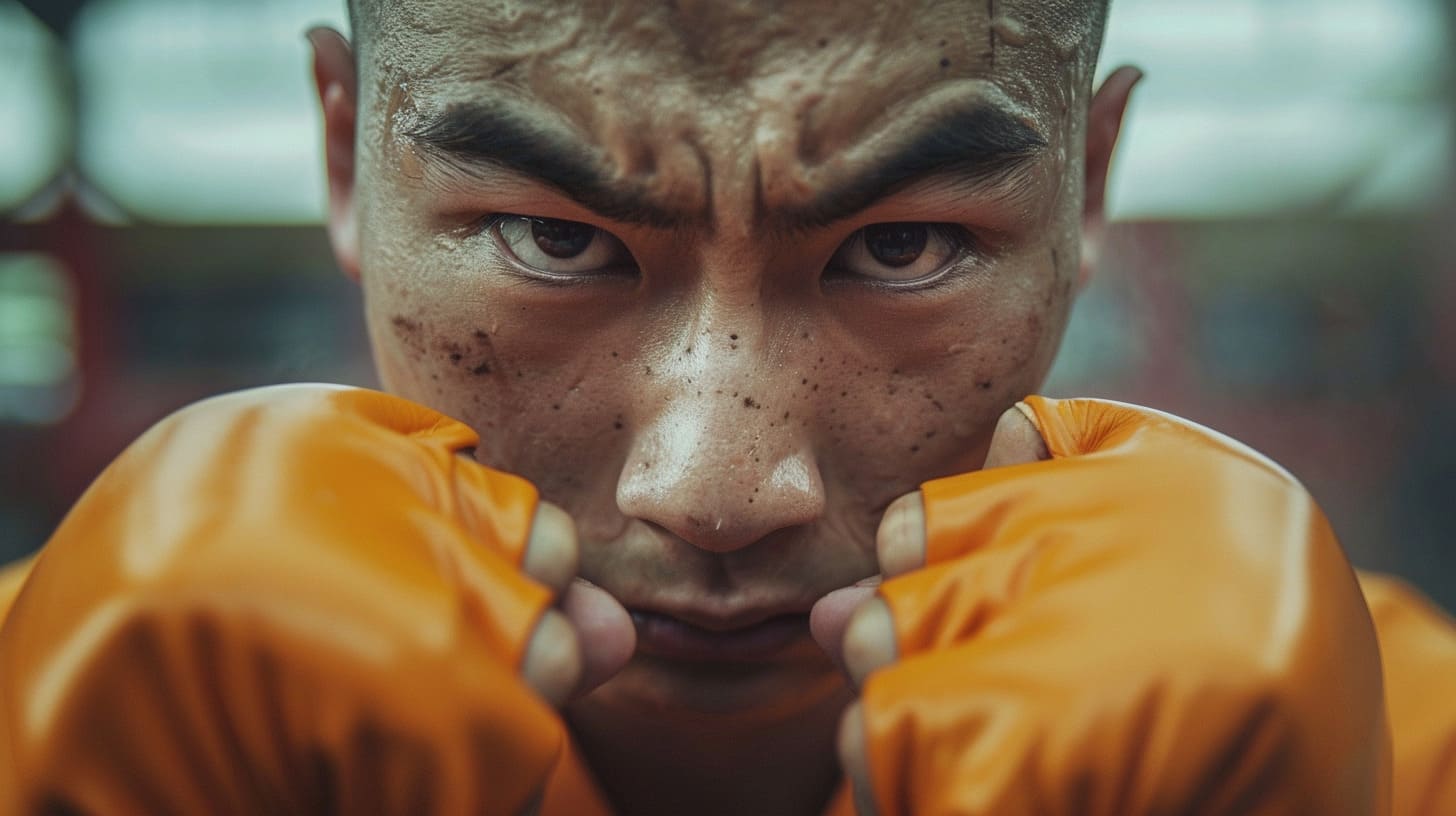Imagine stepping into an ancient world where martial arts are not just about self-defense but also a route to self-discovery. The Shaolin Boxing style, stemming from the venerable Shaolin Temple, is more than a set of fighting techniques; it’s a voyage across time, embracing centuries-old traditions alongside robust physical and spiritual practices. Prepare to unlock an art that demands finesse and complete harmony of mind, body, and spirit.
The Foundations of Shaolin Boxing
The Shaolin Temple Origins
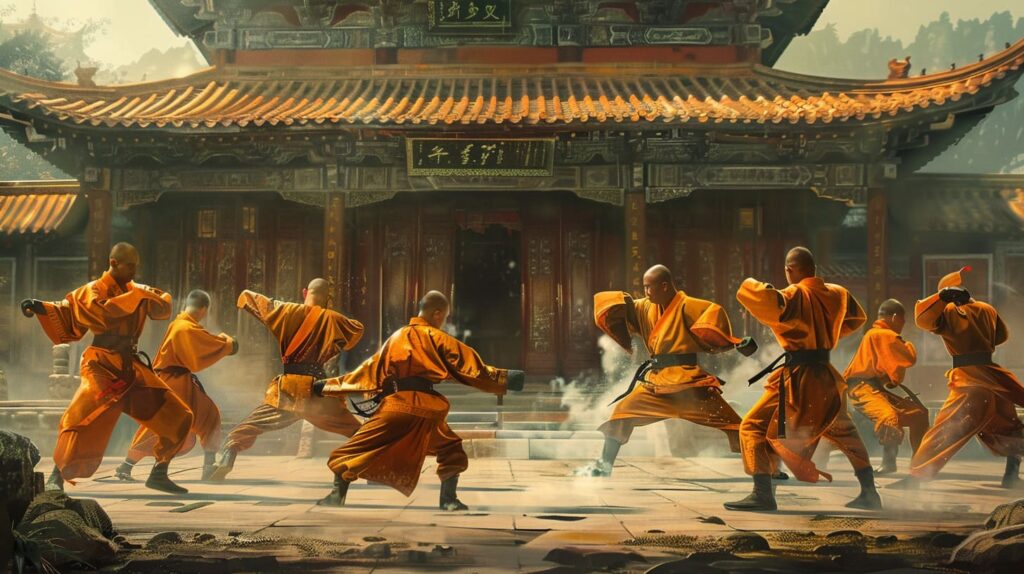
Let’s embark on a journey back to the very source of Shaolin Kung Fu, the Shaolin Temple. Nestled in the serene Henan province of China, this holy site birthed a martial arts legacy over 1500 years ago. Shaolin Boxing, a pivotal branch of the extensive family tree of Kung Fu, stems from this cradle of disciplined combat.
Here’s a quick breakdown of the temple’s significance in Shaolin Boxing:
- Historical Significance: Constructed in the 5th century, the temple has been a martial arts hub for centuries.
- Cultural Heritage: Shaolin Kung Fu’s evolution here has woven it indelibly into China’s cultural fabric.
- Center of Training: Not only a sacred space, this temple is indeed a grounds for training dynasties of warriors in the combative arts.
Philosophy and Principles
Dive deeper, and you’ll realize Shaolin Boxing transcends mere physicality; it weaves the profound threads of Zen Buddhism into its core. It’s an art that shapes the person as much as the practitioner, imbuing them with eternal values like discipline, respect, and a pursuit of inner stillness amidst chaos.
Imagine a training that shapes character through the lens of these principles:
- Discipline: The backbone of the practice, mandating rigorous control over one’s actions and thoughts.
- Respect: A deep-seated reverence for life, opponents, and the martial journey itself.
- Inner Peace: The ultimate goal, fostering tranquility within, even in the eye of the storm.
Training and Discipline
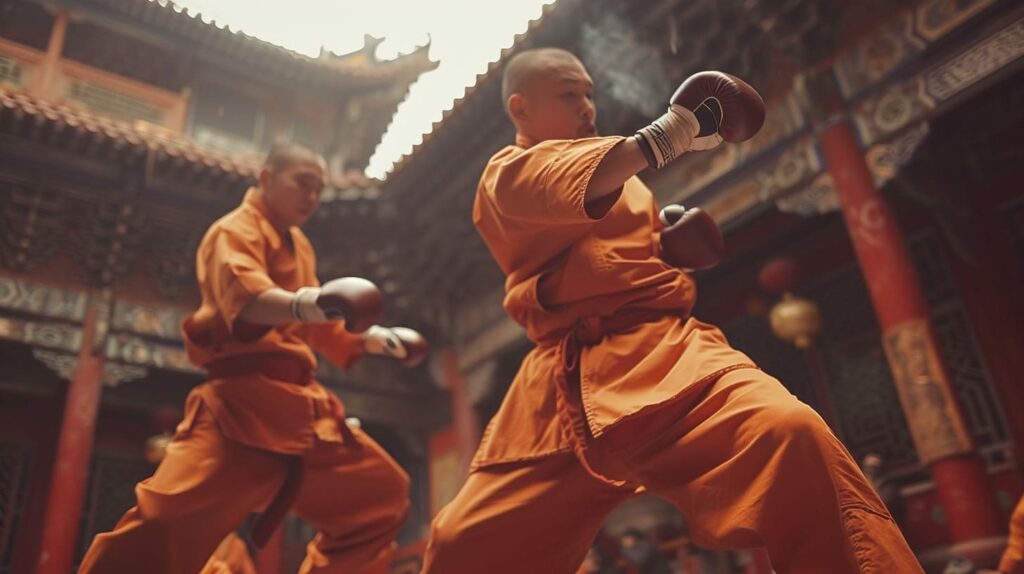
Shaolin Boxing is not for the faint-hearted. It’s an odyssey through intense physical exercise, mind-bending meditation sessions, and the mastery of complex forms, known as katas or taolu. These elements combine to chisel a warrior’s toolset, sharpening both the body and the psyche.
Here’s what sets Shaolin training apart:
- Physical Training: Prepare for intense workouts that push you to the peak of human potential.
- Mental Conditioning: Just as the body flexes, so does the mind, through meditations that elevate focus and mental fortitude.
Stay tuned for the journey into Shaolin Boxing’s style and techniques that have captivated the world. You’ll learn about the fluid animal-inspired moves that call for speed and agility and the signature moves vital for self-defense and competition. Keep reading to discover a martial art that is as humbling to observe as it is exhilarating to practice.
The Style and Techniques of Shaolin Boxing
Picture the poise and grace of a crane or the stealthy prowl of a tiger. This imagery is at the heart of Shaolin Boxing’s rich tapestry of styles. Harnessing the essence of five majestic animals, practitioners mimic their attributes, cultivating a style known for its dynamic fluidity. Let’s venture into how these ancient movements translate into powerful martial arts techniques.
Key Characteristics of Shaolin Boxing Style
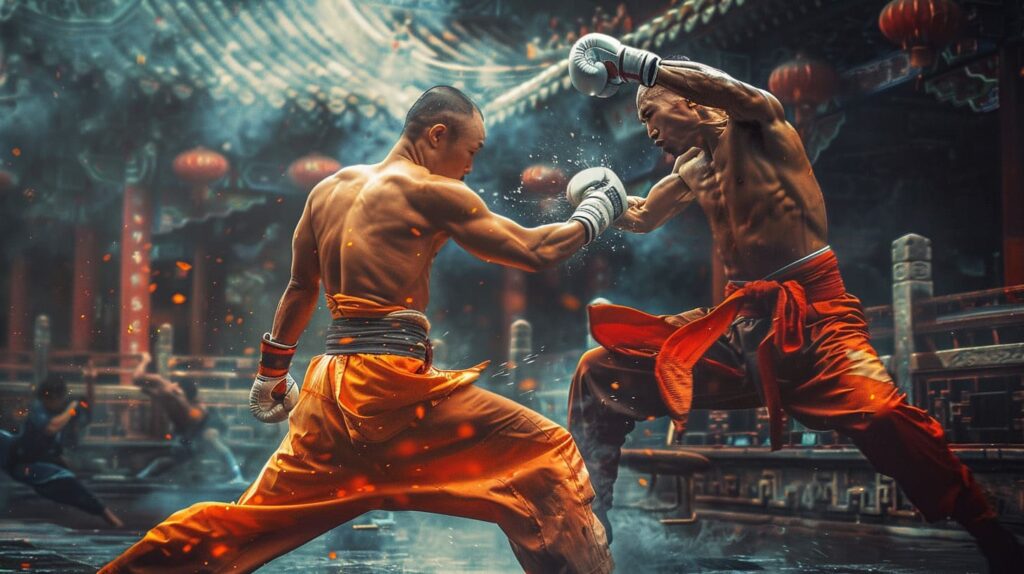
Shaolin Boxing is as distinctive as it is disciplined, drawing inspiration from the animal kingdom. The Tiger style embodies strength, while the Crane represents balance. The Leopard’s speed, the Snake’s fluidity, and the Dragon’s all-encompassing power round out the quintet.
Here’s how these influences shape Shaolin Boxing:
- Animal Instincts: Each style mirrors animal behaviors, teaching fighters to adapt to their surroundings with instinctual precision.
- Movement and Balance: The act of harmonizing agility, speed, and control creates a foundation for all Shaolin techniques.
- Holistic Approach: This isn’t just about fighting—it’s about developing a sense of oneness between movement and thought.
Signature Techniques and Forms
Delving into the specifics, each technique in Shaolin Boxing serves a distinct purpose, whether for self-defense, meditative practice, or competitive sparring. Iconic moves, like the Tiger Claw and Crane Beak, are not simply striking positions but lessons in strategy and precision.
Key techniques include:
- Tiger Claw: A fearsome grab-and-pull technique mimicking a big cat’s deadly paw strike.
- Crane Beak: A precise strike targeting vital pressure points, elegant yet deadly.
- Leopard Fist: Noted for its explosive speed, delivering a power-packed punch.
These forms contribute vastly to a practitioner’s arsenal, providing a versatile toolbox for any scenario inside or outside the ring.
Shaolin Boxing for Self-Defense
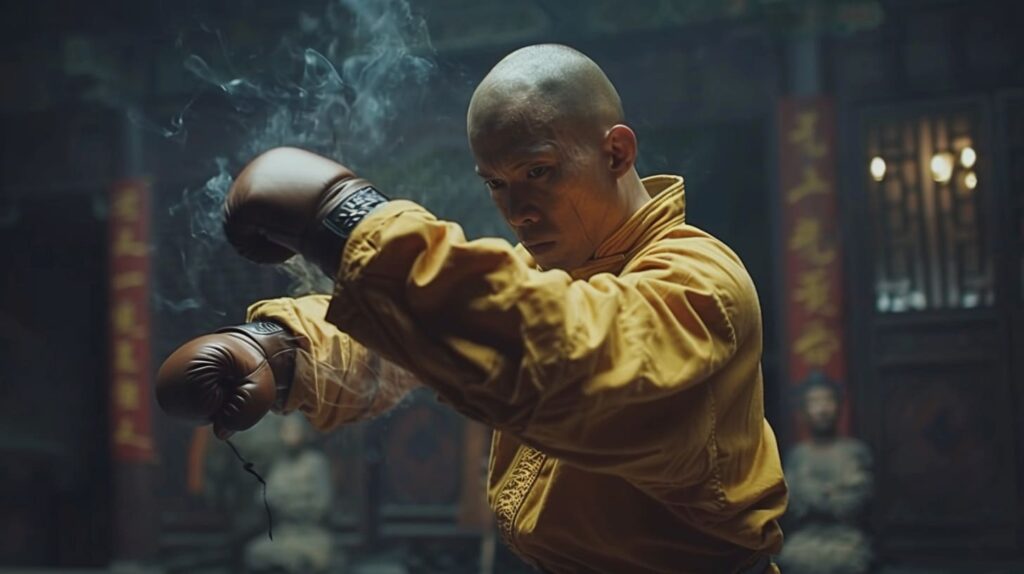
Beyond the dojo, Shaolin Boxing stands out for its practical self-defense applications. Its comprehensive training cultivates not just a robust physique, but also heightened awareness and reflexes, essential for protection in difficult encounters.
Benefits to your well-being include:
- Enhanced Flexibility: Evading harm often depends on agile responses. These practices ensure you’re bendy when it counts.
- Strength and Stamina: Conditioning under Shaolin regimes carves out a stronger, more enduring you.
- Mental Acuity: Expect your cognitive sharpness to rise, as you juggle the multifaceted drills typical of this style.
Embracing this martial art does more than prepare you for confrontations; it sculpts a healthier, more resilient you, capable of facing life’s challenges with ease.
Shaolin Boxing in Popular Culture

Famous Practitioners and Their Impact
Shaolin Boxing isn’t just a whisper from the past; it’s alive and kicking, thanks to some inspiring individuals. The likes of Shi Dejian have not only mastered the art but also propelled it onto the world stage. These practitioners are the cornerstone of Shaolin Boxing, bridging ancient techniques with modern-day relevance and inspiring a new generation to take up the mantle of this storied practice.
Consider these impacts of celebrated Shaolin figures:
- Global Respect: Talents like Shi Dejian garner international recognition, bolstering the reputation of Shaolin Boxing.
- Inspiring Stories: Their journeys depict the true spirit of martial arts, encouraging others to follow suit.
- Teaching and Legacy: More than fighters, they are teachers, passing on wisdom that goes beyond mere physical combat.
Shaolin Boxing in Film and Media

From the ‘70s kung fu craze to today’s action-packed blockbusters, Shaolin Boxing has carved an indelible niche in the film and media landscape. Movies have not only showcased the electrifying moves of Shaolin fighters, but they’ve also cast a light on the profound philosophy underlying each punch and kick.
Here’s how Shaolin Boxing shines on screen:
- Cinematic Showcases: Blockbusters and indie films alike have drawn audiences into the mesmeric world of Shaolin martial arts.
- Documentary Insights: Intimate documentaries present the true essence of Shaolin Boxing, revealing the dedication behind the discipline.
- Perception Shaping: These portrayals have vastly influenced how viewers perceive and appreciate the art form, often becoming their first encounter with the discipline.
The Modern Day Legacy of Shaolin Boxing
Shaolin Boxing isn’t a relic; it’s a living, breathing art, constantly adapting and enduring in the modern era. Today’s temples and schools are living libraries, preserving and sharing this practice with the global community. Far from its birthplace, Shaolin Boxing finds a home in every corner of the planet, from small town dojos to bustling city centers.
Here’s a glimpse at its global footprint:
- Global Adaptations: Adaptations of the style cater to contemporary interests while maintaining core principles.
- Spread by Schools: A worldwide network of schools and temples keeps the tradition alive and growing.
- Cultural Exchange: As an art and a sport, Shaolin Boxing fosters cross-cultural connections, celebrating a shared human heritage.
Getting Involved with Shaolin Boxing
Are you feeling the pull of Shaolin Boxing? Maybe it’s the rich history that intrigues you, or perhaps the allure of mastering such a revered art form. If you’re keen on starting your journey in Shaolin Boxing, there’s a path leading from the ancient steps of the Shaolin Temple to your very doorstep. Let’s explore how you can dip your toes into these age-old waters and become part of a martial arts lineage that’s as storied as it is profound.
Starting Your Own Journey
Alright, so you’ve decided to give Shaolin Boxing a go. Fantastic! Now the real adventure begins. Finding a foothold in this martial arts tradition is about connecting with the right people and places. You’ll want to hunt down a school with experienced teachers who live and breathe Shaolin Kung Fu. Remember, it’s not just about how many punches or kicks you learn, but absorbing the art’s rich philosophy and spirit.
Here’s how to kickstart that journey:
- Investigate Local Schools: Scope out local options where Shaolin Boxing is taught. Try a few classes to get a feel for their approach.
- Authentic Lineage: It’s essential to trace the school’s lineage back to the Shaolin Temple traditions to ensure it’s the real deal.
Choosing your guide on this voyage is critical, so here are some markers of a stellar teacher:
- Experience and Knowledge: A good teacher not only knows the techniques but understands the history and philosophy behind them.
- Passion: They should radiate enthusiasm about the art and be dedicated to teaching others.
- Contribution to Your Growth: Your potential mentor should be concerned with your development as both a martial artist and an individual.
Maintaining the Shaolin Boxing Tradition
In every class, punch, or meditative moment, you’re not just practicing an art; you’re preserving a millennia-old tradition. Your discipline and dedication to learning and teaching perpetuate the Shaolin Boxing legacy, keeping it strong and vibrant for future generations.
What does it mean to keep the torch burning? Check this out:
- Regular Training: This doesn’t just mean hopping into the dojo when the mood strikes—consistent effort is the bedrock of mastery.
- Living the Values: Incorporate the principles of Shaolin Boxing into your everyday life.
If you’re inspired to share your knowledge, here’s what you need to keep in mind:
- Become a Beacon: By teaching others, you become a vital link in the chain of Shaolin Boxing’s rich history.
- Continue Learning: Teachers are lifelong students, continually honing their craft to inspire their charges effectively.
Conclusion
Shaolin Boxing isn’t a mere collection of movements; it’s a thread woven through the tapestry of history, edged with modernity and waiting for you to pull. With every step, punch, or kick, you’re connecting with an art form that has stood the test of time. And who knows? Maybe you’ll find that in learning Shaolin Boxing, you’re not just mastering a martial art—you’re embarking on a transformative personal odyssey. So, lace up your gloves and step into a world where every movement is poetry and every breath is history coming to life. This is your moment to become part of the Shaolin legacy.
Additional Resources
Websites:
- Shaolin Temple Official Website: Dive into the source of it all with the Shaolin Temple’s official site. Learn about the temple’s history, current events, and more about the philosophy that encapsulates Shaolin Boxing. Visit the Shaolin Temple
- Kung Fu Magazine: An extensive collection of articles on all things Kung Fu, including in-depth pieces on Shaolin Boxing. It’s a treasure trove of information for enthusiasts and practitioners alike. Read Kung Fu Magazine
Books:
- “The Complete Book of Shaolin” by Wong Kiew Kit: This comprehensive guide offers insight into Shaolin history, philosophy, and the fundamentals of Shaolin Kung Fu techniques. Get it on Amazon
These resources are a click away and will open up new facets of Shaolin Boxing, from its profound history to the intricate details of its practice. So go on, immerse yourself, and let the journey begin!
